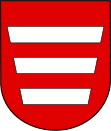Szczebrzeszyn
| Szczebrzeszyn | ||
|---|---|---|

|
|
|
| Basic data | ||
| State : | Poland | |
| Voivodeship : | Lublin | |
| Powiat : | Zamojski | |
| Gmina : | Szczebrzeszyn | |
| Area : | 29.04 km² | |
| Geographic location : | 50 ° 41 ′ N , 22 ° 58 ′ E | |
| Height : | 202 m npm | |
| Residents : | 5153 (December 31, 2016) | |
| Postal code : | 22-460 | |
| Telephone code : | (+48) 84 | |
| License plate : | LZA | |
| Economy and Transport | ||
| Street : | Kielce - Zamość | |
| Rail route : | Warsaw - Rawa Ruska | |
| Next international airport : | Rzeszów-Jasionka | |
Szczebrzeszyn [ ʃtʃɛ'bʒɛʃɨn ] is a Polish city in the powiat Zamojski of the Lublin Voivodeship with around 5,300 inhabitants and the seat of the city-and-country municipality of the same name . Szczebrzeszyn is located on the Wieprz River on the road from Kielce to the Ukrainian border.
history
In the place there was a medieval castle, which should protect the trade route from Kiev to Krakow ("Rotenbürgen"). Originally belonging to the principality of Halych-Volodymyr, Szczebrzeszyn fell to Poland in 1366. Fourteen years earlier, the place name was first mentioned in a document from King Casimir the Great as "city". From the middle of the 16th century it belonged temporarily to the noble Górka family, who made it a center of the Calvinist faith. From around 1550 a large Jewish community settled there. After the transition to the rule of the Zamoyskis in 1593, the economic development was increased, but it also began a recatholicization. In the 17th century Cossacks (1648), Swedes (1656) and Tatars (1672) devastated the city one after the other. In the 18th century a process of economic reorientation began, which made Szczebrzeszyn a center of weaving trade. With the first partition of Poland in 1772 it became Austrian. The authorities of the Duchy of Warsaw , to which it belonged for six years, moved the old academy from Zamość here in 1809, and it existed until 1852. In 1815 Szczebrzeszyn became part of the Russian Congress of Poland , and in 1918 it became Polish again. After the invasion of the Wehrmacht , the occupiers set up a ghetto for the approximately 4,000 Jewish residents of the city. It was dissolved in 1942, and the inmates were deported to Belzec and the Izbica ghetto and murdered. As part of the Zamość campaign , a large part of the local Polish population was also expelled and replaced by forcibly resettled ethnic Germans . Units of the Polish underground army were active in the region , which also liberated the city on July 25, 1944. From 1975 to 1998 it was part of the Zamość Voivodeship .
local community
In addition to the city itself, the urban and rural community of Szczebrzeszyn consists of 13 school offices.
Attractions

Despite the passage of time, a number of historic buildings have been preserved in the city. These include the parish church from 1620, the Franciscan church from 1638 with the converted monastery buildings, a synagogue from the second half of the 18th century, the classical former academy building with professors' houses from 1819 and 1822 and, last but not least, the Greek Catholic church, the oldest Parts date from the 12th century.
Others
For Poles and all Polish learners, the city is known for a tongue twister by the writer Jan Brzechwa . phrase “W Szczebrzeszynie chrząszcz brzmi w trzcinie” [ fʃtʃɛbʒɛˈʃɨɲɛ ˈxʃɔ̃ʃtʃ ˈbʒmʲi ˈftʃtɕiɲɛ ] (for example: "In Szczebrzeszyn the beetle sounds in the reed") is intended to illustrate the problems of pronouncing the multitude of sibilants . The city has erected a monument in honor of Brzechwa showing a violin-playing beetle near a small spring.
Personalities
- Józef Brandt (1841–1915), Polish painter
- Zygmunt Klukowski (1885–1959), hospital doctor and historian of the Holocaust in Szczebrzeszyn
- Kazimierz Kelles-Krauze (1872–1905), Polish socialist politician
literature
- Zygmunt Klukowski : Diary from the years of the occupation: 1939-1944 . Editors Christine Glauning, Ewelina Wanke. Introduction Ingrid Loose. Translation from the Polish Karsten Wanke. Berlin: Metropol, 2017
- Zygmunt Klukowski: Dziennik 1944–1955 , Lublin 1990 (posthumous)

